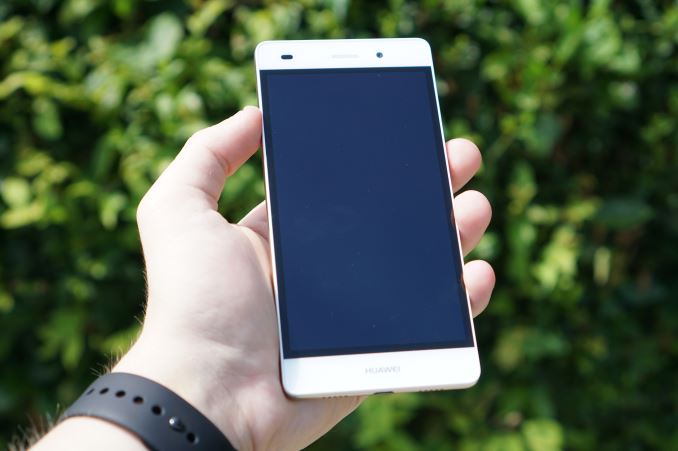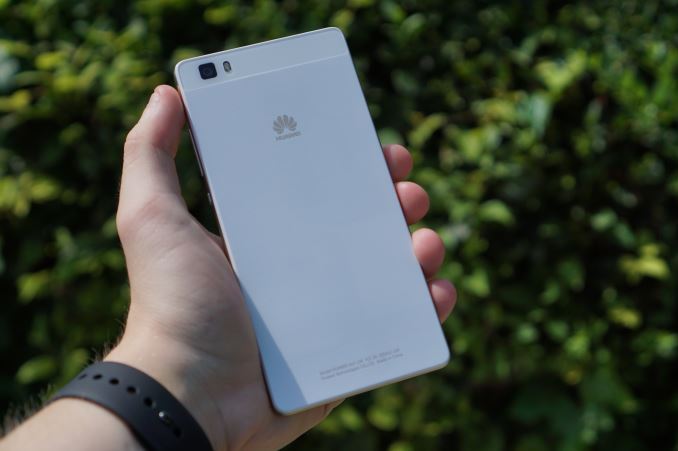The Huawei P8 Lite Review
by Brandon Chester on July 27, 2015 8:00 AM EST- Posted in
- Smartphones
- Huawei
- Mobile
Final Words
Mid range devices in the $200-300 range are more interesting than devices at the low end of the smartphone market because there's more room for OEMs to prioritize some features over others in order to differentiate their device. With low end devices it's often the same story of a Snapdragon 400/410 SoC with 1GB of RAM, 8GB of NAND, a 5MP or possibly an 8MP camera, and a qHD display. In the mid range market OEMs can choose to spend more money on certain areas to improve the experience, whether that be a faster SoC, a better display, better build quality, or better cameras. The P8 Lite represent's Huawei's view on what features are most important in a mid range device.
Build quality is definitely an area of focus on the P8 Lite. The chassis feels sturdy, and it feels fairly good in the hand. At 7.7mm thick it's also much thinner than many other low end and mid range devices, although this results in a compromise on battery capacity. As for the design side of things, I'm personally not the biggest fan due to the metal band around the edges. While I don't know how many people will share this view, I'm disappointed that a single design element ends up ruining the appearance of the phone for me.
The 5.0" 1280x720 display on the P8 Lite is definitely one of its weaker aspects. The calibration is just not near as good as it should be, especially with devices in the sub-$200 bracket becoming very accurate. At 5" the 720p resolution has decent sharpness, but I find myself longing for the 5.5" 1080p panel on the Zenfone 2 which is only $199. Since the display is something you look at all day, Huawei really needs to improve in this area by eliminating the blue shift in the greyscale and improving general color accuracy.
As for performance, Snapdragon 615 is really the best you're going to get at this price point unless you go with the Zenfone 2 which is something of an anomaly in many ways. Huawei is using the bin with the big cluster of A53 cores clocking up to 1.5GHz rather than 1.7GHz like in the HTC One M8s, but it still has significant performance improvements over Snapdragon 400 and 410 in low end devices. There would be even greater gains on the CPU side if it was operating in AArch64 mode, but with the P8 Lite shipping with KitKat it's forced to operate in AArch32 mode. I really don't feel it's acceptable to be shipping any devices with KitKat this late into 2015, as it has performance issues and uses Android's older Dalvik runtime.
The GPU shows even more substantial improvements than the CPU, with performance being anywhere from 1.5x to 3x faster than Adreno 305/306. As far as memory goes, the additional gigabyte of RAM also helps to keep things running smoothly, but NAND quality is definitely an area Huawei needs to continue to improve on. Both random and sequential reads and writes are as slow or slower than the Moto E which at times sells for less than half the price of the P8 Lite. It's hard to say how much of an impact this will have with the workload of a typical P8 Lite buyer, but there's certainly no reason not to improve on areas where devices fall short.
The 13MP rear-facing camera is where the P8 Lite really shines. Shots that aren't taken in the middle of the night end up being better than any other device I've seen at this price point. Much of this is owed to the well balanced processing that Huawei applies to images. Once you get into extreme low light there tends to be a dramatic loss of detail due to excessive noise reduction, and I think image quality would be substantially improved if Huawei would tone it down a few notches when taking photos in the dark.
The quality of videos recorded on the P8 ends up falling short compared to the still image quality. Even with a fairly high bitrate for 1080p video, there's just an overall lack of detail in every frame. Fixed focus also means that there's often blurriness when pointing the camera to new areas, and Huawei needs to work out whatever issues are occurring with the right channel audio recording.
The last important aspect to cover is battery life, and unfortunately this is where the P8 Lite really let me down. The P8 Lite's battery life is unimpressive in our web browsing benchmark, and the very short time in PCMark's battery test just confirms something I continually noticed when using the phone which is that the battery life is too short during general use. This problem is made worse by a very long charge time, which means that the phone dies quickly and takes a long time to be back up and running. Since the P8 Lite doesn't deliver on battery life, I don't know why users wouldn't instead purchase something like the ASUS Zenfone 2 unless they really want the P8's camera quality or smaller size.
Ultimately, there are no bad phones, just bad prices. The P8 Lite wouldn't be a bad recommendation if it was priced a bit lower and received an update to Lollipop. While I don't know if it would be possible for Huawei to reach a price of $150, I would need the P8 Lite to be priced somewhere below $200 before I could really recommend it. At this time there are simply better options in the $200-300 range, and so at its current price point the P8 Lite is a phone I find difficult to recommend.












45 Comments
View All Comments
joeroyhud - Monday, July 27, 2015 - link
The P8 Lite supports LTE band 12, which makes it attractive if you're a T-Mobile customer like I am. I got the phone on sale a couple months ago for $200. I like the size and the performance and the battery life, but it's overpriced at $250.Glock24 - Monday, July 27, 2015 - link
This phone seems like a bad choice. Glad I got a ZenFone 2, but sure since I got the 4GB RAM/64GB flash version it cost me $300. Battery life on ZF2 is not great, but has improved a bit with system updates. I guess if the P8 Lite had Android 5.0 it would have even worse battery life.austinsguitar - Monday, July 27, 2015 - link
g4 pleaseedwd2 - Monday, July 27, 2015 - link
SD615 is a plain no for me. It's arguably worse than the SD600 and the MT6752 smokes it in every aspect at a lower price point.Speedfriend - Tuesday, July 28, 2015 - link
"As for performance, Snapdragon 615 is really the best you're going to get at this price point unless you go with the Zenfone 2 which is something of an anomaly in many ways. "Which begs the question why more manufacturers aren't using Intel chips which clearly smash the performance of any other mid range priced offerings?
Stick an Intel chip in a Moto G and I'll buy that!
LiverpoolFC5903 - Tuesday, July 28, 2015 - link
Agree, I dont understand why more manufacturers do not use the newer Silvermont based Intel chips, considering the performance levels and the low price. Much better than using mediocre socs like Snapdragon 410/615 at similar price points. Having used the ZF2, I can personally attest to its performance in handling anything Android has to offer.Buk Lau - Wednesday, July 29, 2015 - link
The answer is simple, Intel chips don't come with integrated modems. just look at zenfone 2, that thing comes with XMM 7262 with CAT 6 LTE disabled, and if this doesn't show you the problem already, Qualcomm's Gobi modem even comes with integrated GPS solution whereas Asus has to include a Broadcom solution. so just by using these atoms you already have to include 2 other chips whereas Qualcomm just gives you an all-in-one solution. then the choice is obvious, unless intel is literally paying money to you, which they did, what incentive is there for you to use their more complicated solution instead of qualcomm's? and this is how qualcomm got to become what it is today. back in the old days qualcomm's SoCs suffered even worse overheating and performance and yet OEMs still persist to use their stuff, simply because they offered an integrated modem. in a sense, OEMs only have themselves to blame rather than qualcomm for having to release junk phones all over this year, if they didn't spoil qualcomm so much back then, there wouldn't be so little choices in the SoC marketBadelhas - Tuesday, July 28, 2015 - link
The European / Asian version has Lollipop UI Emotion 3.1 and the their own HiSilicon's Kirin 620 SoC. Is it possible to review that one? Seems much better than the American version...A friend of mine bought one and it´s pretty slick, even if I continue to prefer the Moto E, considering the price.
PrinceGaz - Tuesday, July 28, 2015 - link
eww, you've got really hairy arms! (just joking, there were complaints in the comments about the iWatch that the guy wearing it had hairless arms :)So why would I want a phone with eight A53 CPUs? In my experience with a quad-core tablet, it rarely uses more than two of them fully when it is running at full speed, with the third and fourth cores doing a bit of work but hardly ever even approaching fully utilised (probably just running the tasks that need to be run anyway, so their main purpose is taking a tiny bit of work off the other cores).
Given that a 64-bit CPU is a bit unnecessary when phones have yet to reach 4GB RAM, and probably counter-productive power-wise as a result (just look at A15/A7 vs A57/A53), whilst benchmarks may run faster on a quad-core 1.5GHz A53, I suspect I'm better off with my old dual-core 1.7GHz Krait for most daily usage. It lasts me all day and never feels slow, and most of the time (according to a CPU usage monitor) one of the cores isn't being used much. I don't play 3D games much on my phone; so I never tax the GPU, therefore the Adreno 305 is perfectly fine for me,
What workload other than benchmarks requires more than two CPU cores? The main one that occurs to me is a browser, in which case you would be much better off culling battery draining processes rather than running them.
Ethos Evoss - Saturday, August 1, 2015 - link
pls honor 7 reviewthnx